#Statistical trend analysis
Explore tagged Tumblr posts
Text
What Is Trend Analysis in Research? Types, Methods, and Examples
Explore the essence of trend analysis in research, encompassing its diverse types, methodologies, and real-world examples. Unravel the significance of tracking trends to glean insights and make informed decisions in various fields.
#Trend analysis#Research trends#Analyzing trends#Trend analysis definition#Types of trend analysis#Methods of trend analysis#Conducting trend analysis#Utilizing trend data#Research trend identification#Trend spotting#Trend forecasting#Trend analysis techniques#Trend analysis tools#Trend analysis models#Market trend analysis#Statistical trend analysis#Qualitative trend analysis#Quantitative trend analysis#Longitudinal trend analysis#Cross-sectional trend analysis#Trend analysis in research#Trend analysis in data science#Trend analysis in social sciences#Trend analysis in economics#Trend analysis in business#Trend analysis in marketing#Trend analysis in finance#Trend analysis in healthcare#Trend analysis in technology#Trend analysis examples
0 notes
Text
I have such mixed feelings about the love languages thing specifically, because, like, gary chapman fucking sucks and there's no scientific validity to his work BUT
at the same time, i do think there's some value in recognising and discussing the fact that different people need different expressions of love in different amounts? Especially in relationships.
Like, I have just recently been having a discussion with my partner about how he really doesn't tend to express his affection through gifts, whereas (as someone who is mega-bad at expressing sincere feeling) I do rely heavily on giving gifts and doing things for people as a less scary way to express love. Joe doesn't like giving gifts, because he's scared he'll do it wrong, and is only so-so on receiving them. He prefers to express love through physical contact and saying nice things. I hate having nice things said to me unless I am allowed to immediately rebut them with a joke or sarcastic comment that makes them less scarily close to emotional honesty. too many words of affirmation and i will genuinely just start avoiding you because it is painfully awkward to me.
and none of that means we are fundamentally different categories of people, which is where the 5 Love Languages stuff falls into being absolute bollocks. but I have seen, and done, enough throwing the baby out with the bathwater on that to be a little defensive - I think reasonable applications of the concept are actually really quite valuable. and for me, the taxonomy Chapman suggests (words of affirmation, quality time, gifts, acts of service, physical touch) while not at all exhaustive or thorough, is a useful framework to hang those conversations on. bc, like, no, the way people communicate and receive affection is not universal, and from personal experience, assuming that it is can have really significant problems for a relationship.
...you could argue that this is parallel to BMI in terms of "tools being used in totally not the way they should be used" though, tbf.
I can't keep having the same conversations about love languages, mbti, iq, bmi, "brain fully formed at 25" and shit over and over again...
#bmi is my nemesis because i used to write health information for a living#“unhealthy bmi is” NO SHUT UP DON'T MAKE ME WRITE THAT BOLLOCKS#one of my pet projects in my last job was a complete overhaul of all our healthy eating stuff because GAWD#but also my honours project ended up with an interesting potential Science Development coming out of BMI data#which i still think merited further research#ALMOST LIKE BMI IS DESIGNED FOR LARGE-SCALE STATISTICAL ANALYSIS AND NOT INDIVIDUAL USE#i will say though: it doesn't JUST “hang around because of fatphobia and insurance companies”#in scientific use it hangs around because we don't have a better metric#we've been trying to develop a better statistical metric for subcutaneous fat makeup for DECADES#since before bmi even entered common use actually#you don't need to know someone's BMI for healthcare. you do need to know population BMIs for epidemiological analysis.#but under testing other measures of fat distribution#(e.g. hip:waist ratio; waist circumference; net mass; various adjusted combinations of the aforementioned with height)#just do not meet even BMI's fairly low bar for correlation with detailed fat deposit analysis#but the thing is that BMI is a quick and dirty estimate of a complex topic. which is fine when you're looking for population trends.#it is NOT fine when you're trying to make an analysis of an individual person's health or body composition or anything else#it is the equivalent of eyeballing a room full of people and putting them in order based on how old you think they are#it probably does mean you put the OAPs on one side of the room and the babies on the other!#but if you then went up to one individual person like “according to my calculations you're 65 so you must be retiring this year"#there is a high chance that you would have fucked up#both because you probably did not get their age that accurate AND because you are making a bunch of associated assumptions about them#this was a long tangent about a different topic to go off on in the tags#tl;dr BMI isn't completely useless. it's just not remotely useful for any individual person ever.#(see also: biological sex)
129K notes
·
View notes
Text
Automotive Engine Oil Market Size, Share, Growth, Trends, and Forecast 2025-2032

The automotive engine oil market plays a vital role in maintaining the efficiency and longevity of vehicles worldwide. Driven by technological advancements, increased vehicle production, and a growing focus on engine performance, this market is positioned for steady growth. According to SkyQuest Technology, the Automotive Engine Oil Market is projected to reach USD 62.82 Billion by 2032, expanding at a CAGR of 4% during the forecast period. This article delves into the key drivers, segments, trends, and opportunities in the market.
Market Size and Growth Projections
The market for automotive engine oil is experiencing consistent growth, supported by the rising global vehicle fleet and demand for fuel-efficient engines. Innovations in oil formulation to enhance engine performance and reduce emissions are also contributing to market expansion.
Request a Sample of the Report here:
https://www.skyquestt.com/sample-request/automotive-engine-oil-market
Key Market Drivers
Growing Vehicle ProductionThe global increase in vehicle manufacturing, particularly in emerging economies, is boosting the demand for automotive engine oils.
Focus on Fuel EfficiencyStricter emission standards and the demand for improved fuel economy are driving the development of high-performance lubricants.
Increasing Adoption of Synthetic OilsSynthetic engine oils are gaining popularity due to their superior performance, extended drain intervals, and ability to withstand extreme conditions.
Rising Awareness of Engine MaintenanceVehicle owners are becoming increasingly aware of the importance of regular maintenance, leading to consistent demand for high-quality engine oils.
Market Segments
The automotive engine oil market can be segmented based on oil type, vehicle type, and distribution channel:
By Oil Type:
Synthetic
Semi-Synthetic
Mineral
By Vehicle Type:
Passenger Cars
Commercial Vehicles
Two-Wheelers
By Distribution Channel:
Online Retail
Offline Retail
Speak with an Analyst for More Insights:
Regional Insights
North America:The region remains a key market for automotive engine oils, driven by high vehicle ownership and stringent emission norms.
Europe:Europe is witnessing strong growth due to the adoption of advanced synthetic lubricants and a focus on sustainability in automotive industries.
Asia-Pacific:This region dominates the market, fueled by booming vehicle production, rising disposable incomes, and a growing automotive aftermarket.
Latin America & Middle East:Increasing vehicle usage and rising industrialization are contributing to market growth in these regions.
Buy the Report to Get the Full Analysis:
Top Players in the Market
Prominent players in the automotive engine oil market focus on product innovation, partnerships, and geographic expansion to maintain a competitive edge. Key companies include:
Royal Dutch Shell
ExxonMobil Corporation
BP PLC
Chevron Corporation
TotalEnergies SE
Valvoline Inc.
Castrol Limited
Amsoil Inc.
FUCHS Petrolub SE
Sinopec Limited
View full ToC and List of Companies Here: https://www.skyquestt.com/report/automotive-engine-oil-market
Emerging Trends
Development of Bio-Based Engine OilsGrowing environmental concerns are driving the development of bio-based and biodegradable engine oils.
Digitalization in the Automotive AftermarketOnline platforms are becoming a key distribution channel, offering convenience and a wide range of product options.
Focus on Electric and Hybrid VehiclesWhile electric vehicles reduce dependence on traditional engine oils, specialized lubricants for hybrid and electric powertrains are emerging.
Extended Drain IntervalsAdvancements in oil formulations are enabling longer oil change intervals, reducing maintenance costs for vehicle owners.
The automotive engine oil market continues to evolve, driven by innovations in lubricant technology and a focus on sustainability. Companies investing in research and development to meet changing consumer demands and regulatory requirements are well-positioned to thrive in this competitive landscape.
#Automotive Engine Oil Market#Automotive Engine Oil Market Size#Automotive Engine Oil Market Share#Automotive Engine Oil Market Trends#Automotive Engine Oil Market Growth#Automotive Engine Oil Market Outlook#Automotive Engine Oil Market Key Players#Automotive Engine Oil Market Overview#Automotive Engine Oil Market Competitor#Automotive Engine Oil Market Insights#Automotive Engine Oil Market Forecast#Automotive Engine Oil Market Analysis#Automotive Engine Oil Market Statistics#Automotive Engine Oil Market Data#Automotive Engine Oil Market PDF#Automotive Engine Oil Market Excel#Automotive Engine Oil Market Strategy#Automotive Engine Oil Market Innovations
0 notes
Text
Biochar Market Analysis: Growth Trends and Opportunities Through 2031
Biochar Market Analysis: Growth Trends and Opportunities Through 2031
The global biochar market is experiencing remarkable growth as industries and agricultural sectors increasingly recognize its benefits in soil enhancement, carbon sequestration, and sustainable waste management. Biochar, a stable form of carbon produced from biomass pyrolysis, is emerging as a key player in mitigating climate change and promoting circular economy practices. Here's an in-depth look at the market's insights, segmentation, dynamics, regional trends, and emerging opportunities.
Market Insights: The Growing Demand for Biochar
Biochar's multifunctional benefits, such as improving soil fertility, reducing greenhouse gas emissions, and enhancing water retention, are driving its demand across various applications. Its increasing adoption in agriculture, horticulture, and waste management aligns with global sustainability goals. Moreover, the rising focus on renewable energy sources and carbon offset mechanisms is further propelling the market's growth.
Segmental Analysis: Biochar Applications and Feedstocks
The biochar market is segmented based on applications, technology, and feedstock sources:
Applications:
Agriculture: Biochar enhances soil quality, promotes crop yield, and reduces the need for chemical fertilizers.
Animal Husbandry: It is used as an additive in animal feed and bedding, improving livestock health.
Environmental Management: Biochar is applied for wastewater treatment, carbon sequestration, and air purification.
Technology:
Pyrolysis: The most common method for biochar production, known for its efficiency and scalability.
Gasification and Hydrothermal Carbonization: Emerging technologies focusing on improving yield and energy recovery.
Feedstock:
Biochar production utilizes agricultural residues, forestry waste, and organic municipal waste, making it an eco-friendly and cost-effective solution.
Market Dynamics: Drivers, Challenges, and Opportunities
The biochar market's growth is influenced by a mix of driving factors, challenges, and opportunities:
Market Drivers:
The increasing global focus on sustainable agriculture and soil health is a significant growth driver.
Government incentives and carbon credit mechanisms support biochar adoption as a tool for carbon sequestration.
Challenges:
High production costs and limited awareness among end-users can hinder market growth.
The lack of standardized quality parameters for biochar remains a challenge for widespread adoption.
Opportunities:
Advancements in biochar production technologies promise cost reductions and increased efficiency.
Expanding applications in construction and energy storage present new growth avenues.
Regional Insights: Global Market Distribution
The biochar market showcases distinct growth patterns across regions:
North America:
The region leads in biochar adoption, driven by advancements in sustainable farming practices and favorable government policies.
The U.S. dominates the market, emphasizing large-scale carbon offset initiatives.
Europe:
Stringent environmental regulations and a strong emphasis on climate action bolster the demand for biochar in this region.
Countries like Germany and the UK are focusing on biochar for soil remediation and renewable energy projects.
Asia-Pacific:
The rapid industrialization and agricultural expansion in nations like China, India, and Japan drive market growth.
The region also benefits from abundant feedstock availability and increasing awareness of sustainable farming techniques.
Latin America and Africa:
Emerging economies in these regions are adopting biochar for agricultural productivity and waste management.
Favorable climatic conditions and agricultural practices further support biochar utilization.
Key Market Trends: Innovations and Sustainability
Focus on Carbon Sequestration: The role of biochar in reducing atmospheric carbon levels and offsetting emissions is a growing area of focus globally.
Expansion into New Applications: Innovative uses of biochar in energy storage, construction materials, and environmental remediation are expanding its market potential.
Technological Advancements: Innovations in pyrolysis and hybrid production techniques are improving the scalability and cost-effectiveness of biochar production.
Circular Economy Practices: The integration of biochar into waste-to-energy and biomass management projects aligns with the global push for sustainable resource utilization.
Biochar’s Role in a Sustainable Future
The biochar market is poised for significant growth, driven by its expanding applications in agriculture, environmental management, and beyond. While challenges like high production costs persist, technological advancements and increasing awareness of its benefits are creating promising opportunities. As industries and governments work towards sustainability goals, biochar is set to play a pivotal role in shaping a greener and more resilient future.
#biochar market#biochar market Size#biochar market Share#biochar market Trends#biochar market Growth#biochar market Outlook#biochar market Key Players#biochar market Overview#biochar market Competitor#biochar market Insights#biochar market Forecast#biochar market Analysis#biochar market Statistics#biochar market Innovations
0 notes
Text
What Are Biosimilars and Why Do We Need Them?
Being one of the leading database for clinical trials information, the Clival database helps by offering the necessary knowledge and data regarding biosimilar through reporting on clinical trials and drug development life cycle. It includes information about more than 500,000 clinical trials for biosimilars, which are highly similar biologic medical products to an already approved reference medicinal product.
#Clinical Trial Solutions#Clinical Trial Insights#Clinical Trial Statistical Analysis#drug Development Trends#process of Clinical Trial Application
1 note
·
View note
Note
hi! i’m the anon that asked if you would ever write for riize! thank you for answering i totally get what you mean!!🫶 but i wanted to ask if you have like any recommendations of blogs or fics about both nct and riize bc i’ve been searching and searching and can’t find any longer fics like yours!🫶
honestly i wish i had recs for you but im not reading a lot of fic lately, sorry!
#i mentioned this in the tags of another post but when im in the sungchan and/or riize tags for other stuff it seems like modt of the stuff--#that comes up is more blurb style/preference/sm aus so i can see ur struggle to find long fics#i feel like thats sort of the trend w fans of 4th/5th gen groups while 2nd/3rd groups have a lot more creators making longer pieces??#i havent done the statistical analysis dont quote me on it thats just the vibes i get from being in the tags#this isnt a statement on one being better than the other btw theyre just different things#answered#anonymous#talk#text#mine#also tbh part of the reason i dont read a lot of fic is bc theres not a lot of fic written abt my biases so i gotta write my own. alas.
0 notes
Text
youtube
Supercharge Your YouTube Channel with VidIQ!
Unlocking YouTube success is within reach with vid IQ, the ultimate analytics and optimization tool designed for creators at any stage. This video dives into how vid IQ can supercharge our channels by enhancing keyword research, competitor analysis, and video performance insights. Whether we’re aspiring YouTubers or established creators, vid IQ offers features that help us optimize titles, descriptions, tags, and even thumbnails to boost engagement. With real-time statistics and trend alerts keeping us informed about what’s hot in our niche, it’s time to leverage these powerful tools for growth!

#VidIQ #YouTubeSuccess
#youtube#vid IQ#Neturbiz#YouTube growth#video optimization#keyword research#YouTube analytics#content strategy#video SEO#YouTube marketing#competitor analysis#thumbnail optimization#audience engagement#social media sharing#channel audit#real-time statistics#trend alerts#bulk editing#video performance#YouTube tips#creator tools#engagement metrics#video strategy#YouTube success#aspiring YouTubers#established creators#digital marketing#video promotion#content creators#YouTube insights
0 notes
Text
The Growing Need for Labor in the Construction Industry
The construction industry is facing an unprecedented labor shortage, creating a growing need for skilled workers. This demand is driven by several factors, including an aging workforce, increased infrastructure spending, and the evolving landscape of construction projects. Understanding these dynamics is crucial for addressing the challenges and ensuring the industry’s future growth. The Aging…

View On WordPress
#aging construction workforce#attracting young workers to construction#benefits of construction careers#construction employment opportunities#construction industry skills gap#construction industry trends#construction job growth statistics#construction labor market analysis#construction labor shortage#construction workforce demand#future of construction jobs.#growing need for labor in the construction industry#infrastructure investment jobs#recruitment challenges in construction#skilled labor shortage
0 notes
Text
Best Manufacturer & Exporter of Self Tapping Screws in India: Dasset Engineering

Self-tapping screws are essential components in various industries, known for their ability to create their own threads as they are driven into materials. In India, one company stands out for its excellence in manufacturing and exporting these vital fasteners—Dasset Engineering. Renowned for its commitment to quality, innovation, and customer satisfaction, Dasset Engineering has established itself as a leader in the self-tapping screw industry.
Why Self-Tapping Screws?
Before delving into Dasset Engineering’s contributions, it is crucial to understand why self-tapping screws are so valuable. Unlike traditional screws that require pre-drilled holes, self-tapping screws can create threads as they are driven into materials. This feature makes them incredibly versatile and efficient, reducing the need for additional tools and saving time during assembly. They are widely used in automotive, construction, electronics, and woodworking industries due to their convenience and reliability.
Dasset Engineering: A Legacy of Excellence
Dasset Engineering has built a strong reputation over the years as a top manufacturer and exporter of self-tapping screws. Their success can be attributed to several key factors:
Quality Assurance
Quality is the cornerstone of Dasset Engineering’s operations. The company employs stringent quality control measures at every stage of production, from raw material selection to the final inspection. Their self-tapping screws are made from high-grade materials, ensuring durability, strength, and corrosion resistance. This commitment to quality ensures that their products meet and exceed industry standards, providing customers with reliable and long-lasting solutions.
Advanced Manufacturing Facilities
Dasset Engineering boasts state-of-the-art manufacturing facilities equipped with the latest machinery and technology. These advanced facilities enable the company to produce a wide range of self-tapping screws in various sizes, designs, and specifications. Their manufacturing process is streamlined and efficient, allowing for high-volume production without compromising on quality.
Innovative Designs
Innovation is at the heart of Dasset Engineering’s product development strategy. The company continually invests in research and development to create innovative screw designs that cater to the evolving needs of different industries. Their self-tapping screws are designed for optimal performance, with features such as sharp cutting edges, precise threading, and superior holding power. This dedication to innovation ensures that Dasset Engineering remains at the forefront of the industry.
Customization Options
Understanding that different projects have unique requirements, Dasset Engineering offers customization options for their self-tapping screws. Customers can specify dimensions, materials, coatings, and other parameters to meet their specific needs. This flexibility makes Dasset Engineering a preferred choice for businesses looking for tailored solutions.
Global Reach
As a leading exporter, Dasset Engineering has a strong presence in international markets. Their self-tapping screws are in high demand worldwide, thanks to their reputation for quality and reliability. The company has a robust logistics network that ensures timely delivery to customers across the globe, making them a trusted partner for businesses in various industries.
Customer-Centric Approach
Dasset Engineering’s success is also driven by its customer-centric approach. The company prioritizes customer satisfaction by offering excellent after-sales support, technical assistance, and responsive service. Their team of experts is always ready to assist customers with their queries and provide guidance on the best solutions for their projects.
Conclusion
Dasset Engineering stands out as the best manufacturer and exporter of self-tapping screws in India, thanks to its unwavering commitment to quality, innovation, and customer satisfaction. Their advanced manufacturing facilities, innovative designs, and customer-centric approach make them a trusted partner for businesses across various industries. Whether you are in the automotive, construction, electronics, or woodworking sector, Dasset Engineering offers reliable and high-performance self-tapping screws that meet your needs and exceed your expectations.
#PET bottle recycling process explained#Plastic bottle lifecycle analysis#Importance of PET bottle recycling#Steps in PET bottle recycling#Environmental impact of PET recycling#Sustainable PET bottle management#PET bottle disposal and recycling#Recycling journey of plastic bottles#PET bottle recycling technology#Benefits of PET bottle recycling#Circular economy and PET recycling#Innovations in PET bottle recycling#PET recycling best practices#PET bottle recycling facilities#Role of Lyka Global Plast in PET recycling#Impact of PET recycling on the environment#Challenges in PET bottle recycling#Consumer awareness of PET recycling#Future of PET bottle recycling#PET recycling trends and insights#PET bottle recycling process steps#Sustainable solutions for plastic bottle disposal#PET bottle recycling initiatives worldwide#Environmental benefits of PET bottle recycling#PET bottle recycling impact on climate change#Effective PET bottle waste management strategies#PET bottle recycling rates and statistics#Innovations in PET bottle recycling technology#Circular economy principles in PET recycling#Best practices for PET bottle collection and sorting
0 notes
Text
The Flourishing Beauty and Personal Care Industry in India
The beauty and personal care industry in India is experiencing phenomenal growth, driven by a confluence of factors. From a market valued at approximately INR 850.7 crores (USD 105 million) in 2018, it's projected to reach a staggering INR 1,612.9 crores (USD 200 million) by 2026, reflecting a remarkable CAGR (Compound Annual Growth Rate). Let's explore the key statistics, growth catalysts, market trends, and prominent players shaping this vibrant space in the heart of Asia.

Market Size and Growth Trajectory:
Current Value: As mentioned above, the Indian BPC industry boasts a current market size of approximately INR 850.7 crores (USD 105 million).
Growth Drivers: Several factors propel the industry's remarkable growth:
Rising disposable income: Increased spending power allows consumers to invest in a wider range of beauty and personal care products.
Urbanization and changing lifestyles: Busier lifestyles in urban centers fuel demand for convenient and effective BPC products.
Growing awareness of personal care: Increased access to information and media exposure foster a focus on personal grooming and beauty.
E-commerce boom: Online platforms provide wider product selection and accessibility, particularly in Tier 2 and Tier 3 cities.
Market Trends Shaping the Future:

The Natural and Organic Revolution: Indian consumers are increasingly prioritizing natural and organic ingredients like amla, aloe vera, coconut oil, and argan oil, seeking alternatives to chemical-laden products.
Focus on Specific Needs: Brands are developing innovative products that cater to various hair, skin, and body concerns, such as hair fall control, anti-aging solutions, and targeted skincare for different skin types.
Men's Grooming Boom: The men's grooming segment is experiencing rapid growth, with brands offering specialized products tailored to men's needs and preferences.
Rise of Digital Influence: Social media influencers and beauty bloggers significantly impact consumer purchasing decisions, creating a demand for innovative and trendy products.
Market Players: A Mix of Domestic Powerhouses and Global Giants:
The Indian BPC industry is a competitive landscape with both established domestic players and multinational corporations vying for market share:
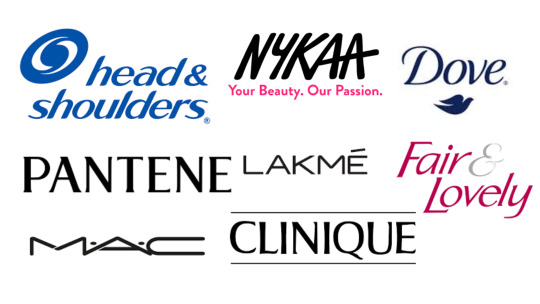
Domestic Powerhouses: Leading Indian brands like Marico (Parachute, Livon), Dabur, Emami, Himalaya Wellness, and Nykaa (a prominent online beauty retailer) hold a significant share in the market.
Global Giants: Established multinational corporations like Unilever (Dove, Sunsilk), L'Oréal, Procter & Gamble, and Estee Lauder also play a crucial role, offering a diverse range of beauty and personal care products.
Key Takeaways for Success in the Indian BPC Market:
Understanding the market dynamics is crucial for businesses aiming to thrive in this dynamic space:
Prioritize Natural Formulations: Develop products that cater to the growing demand for natural and organic ingredients.
Innovation and Specific Solutions: Focus on research and development to create innovative products addressing specific hair, skin, and personal care needs.
Embrace E-commerce: Utilize online platforms to expand reach and cater to a wider audience across India.
Men's Grooming Segment: Develop targeted product lines catering to the expanding men's grooming market.
Leverage Digital Marketing: Utilize social media and influencer marketing to connect with beauty-conscious consumers effectively.
Conclusion:
India's BPC industry presents a compelling picture of growth and vibrancy. By understanding the market size, growth drivers, key players, and evolving trends, businesses can capitalize on the immense potential this market offers. Embracing innovation, prioritizing natural ingredients, and adapting to changing consumer preferences are key strategies to navigate this dynamic and ever-evolving landscape.
#beauty and personal care industry in india#beauty and personal care market#beauty personal care industry#personal care industry growth rate#personal care products industry trends#personal care service industry#personal care products industry#personal care industry analysis#personal care industry growth#personal care industry size#personal care industry in india#personal care industry statistics#personal care ingredients market
0 notes
Text
Polyvinyl Chloride (PVC) Market is poised to grow at a CAGR of 4% by 2028. Increasing Application in the Healthcare and Medical Devices Industries is fueling Polyvinyl Chloride (PVC) Industry.
#Polyvinyl Chloride (PVC) Market#Polyvinyl Chloride (PVC) Market Report#Polyvinyl Chloride (PVC) Industry Report#Polyvinyl Chloride (PVC) Market Size#Polyvinyl Chloride (PVC) Market Share#Polyvinyl Chloride (PVC) Market Growth#Polyvinyl Chloride (PVC) Market Trends#Polyvinyl Chloride (PVC) Market Forecast#Polyvinyl Chloride (PVC) Market Analysis#Polyvinyl Chloride (PVC) Market Outlook#Polyvinyl Chloride (PVC) Market Overview#Polyvinyl Chloride (PVC) Market Statistics#Polyvinyl Chloride (PVC) Market Value
0 notes
Text
Reblog bc I made the charts easier to read and now each character has a consistent color! Thanks to @linderosse for that suggestion! :D
And another disclaimer: the duo tag does not necessarily mean those characters or their relationship is the focus of the fic.
Linked Universe Fanfiction Statistics – Duos
I was interested in what the most common duos are in LU fanfiction, so this happened :D. These statistics are based on tagged fanfictions on AO3 (as of 9am EST 11/08/2023). I'm counting a 'duo' fic as one tagged with "Link 1 & Link 2," like "Twilight & Wild" for example.
First, here are some totals.

I interpret the percentages like this: if the percentage is higher, that character has the spotlight in more fics; if the percentage is lower, that character is more often a background character.
Some observations here: I don’t think it’s surprising that Wild has the most duo fics. I was surprised that Time’s rank changed so much from total fics to total duo fics. And poor Four has the least of all categories :(
Next, I made graphs of all the duos for each character. I’ll put them here in order of most to least fanfics. NOTE: the lefthand axis has different numbers for each link.


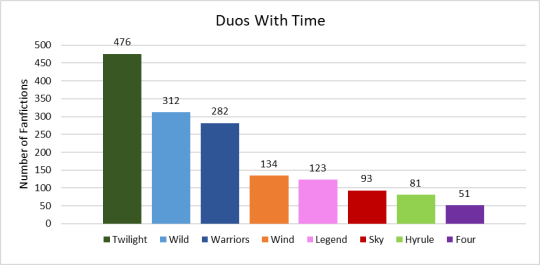
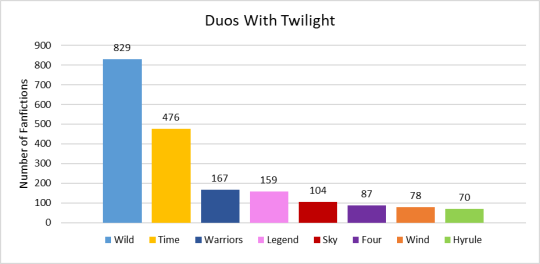

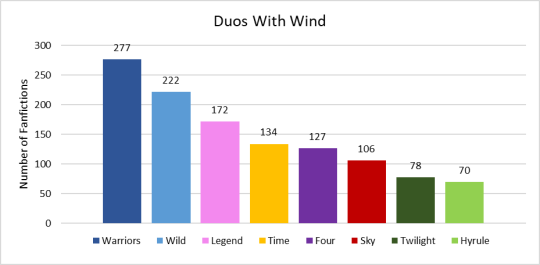

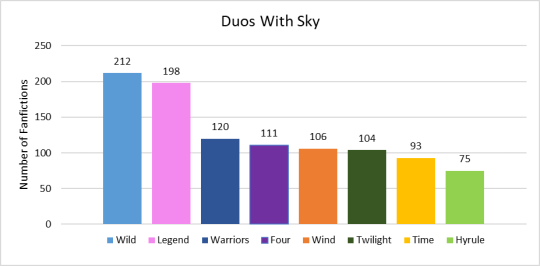
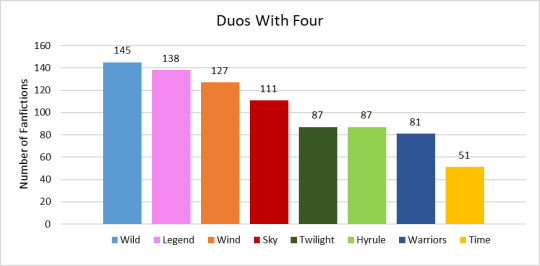
Lastly, I made five ranks for numbers of fanfictions for each specific duo. The ranks are: more than 300 fics, 200-299 fics, 150-199 fics, 100-149 fics, and less than one hundred fics per duo.





Some more observations:
I was very surprised that Legend & Hyrule had the second most. Good for them! I was expecting Warriors & Wind to be higher.
Hyrule and Four make up most of the < 100 category. Wild and Legend don’t show up in that category.
Four, Sky, and Wind are the only ones not in the top category. Four actually doesn’t show up in the top three categories, so none of the duos with Four have more than 150 fics. I also noticed that Wild’s least duo (145 with Four) is Four’s most.
Twilight has the highest range: it goes from 829 – 70. The smallest range is Four: 145 – 51.
There you go! This was super super fun. The autism was going brrrrrrrrr and I worked on this for like 5 hours straight. If anyone has any LU statistics questions, please share them with me! :D:D:D
#this is just for fun my dudes#not meant to be a scientific study#i am aware that it does not cover every single fic in existence.#I just wanted to know the general trends!#FOR FUN#plz just look at this for fun#if you’re reading this I can assure this mini rant is not directed at you#linked universe#the lu boyos#ace's lu analysis#lu analysis#lu statistics#statistics
236 notes
·
View notes
Text
Hydrogen Energy Storage Market Size, Share & Growth | Forecast 2025-2032

The hydrogen energy storage market is emerging as a critical component in the global transition to renewable energy, driven by increasing demand for clean energy solutions, technological advancements, and supportive government policies. According to SkyQuest Technology, the Hydrogen Energy Storage Market size is poised to reach to USD 22.60 Billion by 2032, growing at a CAGR of 4.4% during the forecast period. This market offers innovative solutions to meet energy storage demands while addressing environmental concerns.
Market Size and Growth Projections
The hydrogen energy storage market is witnessing significant growth as industries and governments focus on decarbonization and clean energy. Hydrogen's ability to store energy over long periods and its role in balancing supply and demand are pivotal in accelerating its adoption.
Request a Sample of the Report here: https://www.skyquestt.com/sample-request/hydrogen-energy-storage-market
Key Market Drivers
Global Push for Clean Energy Increasing pressure to reduce carbon emissions is driving investments in hydrogen energy storage technologies.
Energy Resilience and Grid Stabilization Hydrogen storage solutions provide critical support for grid balancing, enabling consistent energy supply.
Government Policies and Incentives Policies aimed at promoting green hydrogen production and usage are accelerating market growth.
Integration with Renewable Energy Sources Hydrogen enables efficient storage of surplus energy generated by solar and wind systems, enhancing their viability.
Market Segments
The hydrogen energy storage market is segmented based on storage type, end-user, and application:
By Storage Type:
Liquid Hydrogen
Gas Hydrogen
Solid Hydrogen
By End-User:
Industrial
Commercial
Residential
By Application:
Transportation
Stationary Power
Portable Power
Speak with an Analyst for More Insights: https://www.skyquestt.com/speak-with-analyst/hydrogen-energy-storage-market
Regional Insights
North America: The region dominates the market, driven by government initiatives and investments in green hydrogen technologies.
Europe: Europe's commitment to achieving net-zero emissions is fostering the adoption of hydrogen energy storage solutions across various sectors.
Asia-Pacific: The region is experiencing rapid growth due to rising industrialization, urbanization, and investments in renewable energy.
Latin America & Middle East: These regions are leveraging hydrogen to address energy security challenges and support sustainable development.
Buy the Report to Get the Full Analysis: https://www.skyquestt.com/buy-now/hydrogen-energy-storage-market
Top Players in the Market
Key players in the hydrogen energy storage market are investing in research and development to offer advanced and cost-effective solutions. Prominent companies include:
Air Liquide
Linde PLC
Cummins Inc.
Nel ASA
Plug Power Inc.
Ballard Power Systems
ITM Power PLC
Hydrogenics Corporation
McPhy Energy S.A.
Chart Industries, Inc.
View Full ToC and List of Companies here: https://www.skyquestt.com/report/hydrogen-energy-storage-market
Emerging Trends
Advancements in Electrolyzer Technology Innovations in electrolyzers are reducing costs and enhancing hydrogen production efficiency.
Green Hydrogen Adoption The growing preference for hydrogen produced from renewable sources is transforming the market landscape.
Expansion of Hydrogen Refueling Infrastructure Development of hydrogen refueling stations is supporting the adoption of fuel cell electric vehicles (FCEVs).
Industrial Applications of Hydrogen Hydrogen is increasingly being used in industries such as steel production, chemical manufacturing, and ammonia synthesis.
The hydrogen energy storage market holds immense potential as the world shifts toward sustainable and clean energy solutions. By focusing on technology, scalability, and integration with renewable energy systems, companies can leverage significant growth opportunities in this dynamic market.
#Hydrogen Energy Storage Market#Hydrogen Energy Storage Market Size#Hydrogen Energy Storage Market Share#Hydrogen Energy Storage Market Trends#Hydrogen Energy Storage Market Growth#Hydrogen Energy Storage Market Outlook#Hydrogen Energy Storage Market Key Players#Hydrogen Energy Storage Market Overview#Hydrogen Energy Storage Market Competitor#Hydrogen Energy Storage Market Insights#Hydrogen Energy Storage Market Forecast#Hydrogen Energy Storage Market Analysis#Hydrogen Energy Storage Market Statistics#Hydrogen Energy Storage Market Data#Hydrogen Energy Storage Market PDF#Hydrogen Energy Storage Market Excel#Hydrogen Energy Storage Market Strategy#Hydrogen Energy Storage Market Innovations
0 notes
Text
“My most recent research study, which included more than 17,000 fifth-grade through 12th-grade girls in The Girls’ Index, reveals a troubling trend: 67% of the participants reported that they don’t say what they’re thinking or disagree with others because they want to be liked. Let that sink in for a moment. Two-thirds of girls are silencing themselves to be accepted.”
“Other findings from our survey are just as stark and, frankly, terrifying. Since 2017, the percentage of girls reporting confidence has declined from 68% to just 55%. A staggering 53% of girls report feeling persistently sad or hopeless. As one seventh-grade girl told us, “Girls my age don’t feel happy the way we are. We want to be someone else.” Reading this, I feel a painful twinge of recognition — like I’m hearing my younger self speak.
We also discovered that two-thirds of girls reported that their body image negatively impacts their confidence. Two-thirds! And nearly 60% of high school girls said they don’t believe they’re smart enough for their dream jobs.”
My analysis ⬇️
This is very disappointing, but it is no surprise. Undergoing female socialization means being conditioned to constantly monitor how you appear to other people.
Questions such as “am I being respected right now”, “do I agree with what is being said”, “do I feel healthy” take the background, while questions like “do I seem nice and kind”, “how can I get this person to like me” and “do I look pretty/skinny/young” take the forefront instead. This is an exhausting way to live.
In the political sphere, women are being asked to first change the language around how we think about our issues before we can talk about them. The specific words we use are often more important to those on the left than the actual content of what we are saying. Making sure we appear politically correct is being made more important than choosing the words that best reflect what we want to say. Often, changing our language so we can appear to be kind and considerate towards others completely obfuscates our points and issues.
As someone I forget so brilliantly put it, we are more concerned with saying nothing wrong than doing something right.
This preoccupation with appearance has a much deeper effect on the lives of women than most take for granted.
819 notes
·
View notes
Text
Double dose of articles about how crime is actually plummeting
From the UK:
"Seventy-eight per cent of people in England and Wales think that crime has gone up in the last few years, according to the latest survey. But the data on actual crime shows the exact opposite.
As of 2024, violence, burglary and car crime have been declining for 30 years and by close to 90%, according to the Crime Survey for England and Wales (CSEW) – our best indicator of true crime levels. Unlike police data, the CSEW is not subject to variations in reporting and recording.
The drop in violence includes domestic violence and other violence against women. Anti-social behaviour has similarly declined. While increased fraud and computer misuse now make up half of crime, this mainly reflects how far the rates of other crimes have fallen.
All high-income countries have experienced similar trends, and there is scientific consensus that the decline in crime is a real phenomenon.
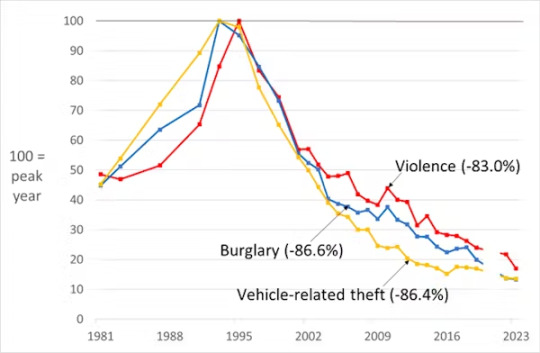
The perception gap
So why is there such a gulf between public perception and the reality of crime trends? A regular YouGov poll asks respondents for their top three concerns from a broad set of issues. Concern about crime went from a low in 2016 (when people were more concerned with Brexit), quadrupled by 2019 and plummeted during the pandemic when people had other worries. But in the last year, the public’s concern about crime has risen again.
There are many possible explanations for this, of which the first is poor information. A study published in 1998 found that “people who watch a lot of television or who read a lot of newspapers will be exposed to a steady diet of crime stories” that does not reflect official statistics.
The old news media adage “if it bleeds, it leads” reflects how violent news stories, including crime increases and serious crimes, capture public attention. Knife crime grabs headlines in the UK, but our shock at individual incidents is testament to their rarity and our relative success in controlling violence – many gun crimes do not make the news in the US.
Most recent terrorist attacks in the UK have featured knives (plus a thwarted Liverpool bomber), but there is little discussion of how this indicates that measures to restrict guns and bomb-making resources are effective."
-via The Conversation, May 13, 2024
And the United States:
"[The United States experienced a spike in crime rates in 2020, during the pandemic.] But in 2023, crime in America looked very different.
"At some point in 2022 — at the end of 2022 or through 2023 — there was just a tipping point where violence started to fall and it just continued to fall," said Jeff Asher, a crime analyst and co-founder of AH Datalytics.
In cities big and small, from both coasts, violence has dropped.
"The national picture shows that murder is falling. We have data from over 200 cities showing a 12.2% decline ... in 2023 relative to 2022," Asher said, citing his own analysis of public data. He found instances of rape, robbery and aggravated assault were all down too.
Yet when you ask people about crime in the country, the perception is it's getting a lot worse.
A Gallup poll released in November found 77% of Americans believed there was more crime in the country than the year before. And 63% felt there was either a "very" or "extremely" serious crime problem — the highest in the poll's history going back to 2000.
So what's going on?
What the cities are seeing
What you see depends a lot on what you're looking at, according to Asher.
"There's never been a news story that said, 'There were no robberies yesterday, nobody really shoplifted at Walgreens,'" he said.
"Especially with murder, there's no doubt that it is falling at [a] really fast pace right now. And the only way that I find to discuss it with people is to talk about what the data says." ...
For cities like San Francisco, Baltimore and Minneapolis, there may be different factors at play [in crime declining]. And in some instances, it comes as the number of police officers declines too.
Baltimore police are chronically short of their recruitment goal, and as of last September had more than 750 vacant positions, according to a state audit report...
In Minneapolis, police staffing has plummeted. According to the Star Tribune, there are about 560 active officers — down from nearly 900 in 2019. Mannix said the 2020 police killing of George Floyd resulted in an unprecedented exodus from the department...
In Minneapolis, the city is putting more financial resources into nontraditional policing initiatives. The Department of Neighborhood Safety, which addresses violence through a public health lens, received $22 million in the 2024 budget."
-via NPR, February 12, 2024
#crime#violate crime#united kingdom#england#wales#united states#us politics#baltimore#san francisco#police#defund the police#good news#hope
1K notes
·
View notes
Text
BG3 Fanfiction Statistics, Part 2
Welcome to part 2 of my BG3 AO3 fanfic statistical analysis! In part 1, which can be found here, I discussed general fanfic data for the fandom and took a look at pairing trends for the player character, Shadowheart, Karlach, Lae’zel, and Minthara. In this section, I will discuss pairing trends on AO3 for Astarion, Gale, Wyll, and Halsin, then compare all 8 main characters and talk about pairings more broadly.
Please note that the data for this analysis was gathered between July 21, 2024 and July 24, 2024. I gathered data for the top 300 ship tags in the BG3 fandom, and due to time constraints did not look at pairings with fewer than 5 fics.
I will try and be as transparent as possible when discussing how I obtained and processed this data. A copy of my spreadsheet can be found here and contains all of the tables I will be discussing for anyone who wishes to take a closer look at the data. If you don’t care about the numbers and/or my thoughts about them, feel free to skim through this post and just look at the charts!
I will be referencing the “PC” a lot in this section. See part 1 for an explanation of my methodology, but basically I combined Tav, Dark Urge, Original Character, Reader, and You into one Player Character (PC) supercategory while filtering to prevent double counting. This makes it clearer who each character is typically paired with. It also drops the number of ships from 300 to 162. Throughout this essay, I will use “ship tags” to refer to the original 300 ships that I gathered the data for and “pairings” to refer to the 162 ships that remain when I condense the player character down.
CHARACTER PAIRING STATISTICS, CONT.
In part 1, I went through Tav, the Dark Urge, Shadowheart, Karlach, Lae’zel, and Minthara and took a look at who they are shipped with and their fic category (F/M, M/M, F/F, Other, Multi) breakdown. In this continuation, I will look at Astarion, Gale, Wyll, and Halsin.
ASTARION
Astarion was included in 50.2% of all fic pairings (the number of fics tagged Astarion/PC + the number of fics tagged Astarion/Gale + the number of fics tagged Astarion/Halsin and so on, divided by the total sum of all fic pairings). This percentage increased to 53.9% when otp:true was applied. This means that over half of all shipping content for BG3 on AO3 involves Astarion!

Astarion is in 7 of the top 10 ship tags and 64 of the top 300 ship tags. When I condense the pairings with the PC down, he is in 7 of the top 30 ships and 40 of the 162 total pairings. The loss of 24 ship tags comes from me having to condense down not only all his ship tags with the PC but also all his threesomes and foursomes and moresomes with the PC.
Notably, Astarion was the only BG3 character to have race specific ship tags – Astarion/Tiefling!OC (68 fics), Astarion/Half-Elf!OC (27 fics), and Astarion/Drow!OC (9 fics). These all got condensed down into the Astarion/PC supercategory as well.

Astarion/Gale is #4 and his next pairings with a non-player character are #8 Halsin and #9 Wyll. Pairings #1, 2, 3, 5, 6, 7, 10, and 16 are all just him with different tags for the player character. Condensing down all the player character tags yields us his top 20 pairings.

As expected, the player character dominates his pairings with 11,756 fics. His biggest non-PC ships are with Gale with 2,431 fics (of which an unusually high proportion are otp:true – 1,752 – almost three quarters of all his fics with Gale), Halsin with 848 fics, and Wyll with 582 fics. Ignoring the PC, he mostly seems to be shipped with men – the first canon woman to show up is Karlach at #8 with 157 fics (an order of magnitude less than Gale). He has four threesomes (Halsin/PC/Astarion, Gale/PC/Astarion, Karlach/Wyll/Astarion, Wyll/PC/Astarion) in his top 20 ships. I was surprised at how high Cazador (#6, 387 fics) was at first, but a lot of that is likely from Astarion’s backstory.
#20 was Astarion/Astarion with 15 fics, which means that Astarion is following in the proud tradition of tumblr sexymen like the Onceler before him.

As expected from looking at Astarion’s pairings in general, he has slightly more M/M (8,923 fics) shipping than M/F (7,996 fics) shipping. M/M pairings have an unusually high rate of otp:true fics – that’s mostly from Astarion/Gale. Oddly, there’s a small number (51) of F/F otp:true fics – these are either genderbends or mistags.
Looking at the pattern of pairings with the PC only, a different pattern emerges.

This time, there’s significantly more M/F fics (6,910, 58.8% of Astarion’s fics with the PC) than M/M fics (4,182, 35.6%), though the numbers are closer when you look at otp:true (46.7% M/F vs 37.6% M/M). We can infer then that it is more common to ship female player characters with Astarion than men. The Other category is significant (1,601 fics, 13.6%) and likely was used for a tag for nonbinary player characters. There’s still a bizarre 38 otp:true F/F fics.
GALE
Gale is in 19.7% of all pairings and 26.5% of otp:true pairings. He has 33 ship tags in the top 300, which drops to 23 when I condense all the player characters into “PC.”

Unlike Astarion, whose chart was completely dominated by his pairing with the PC, Gale has almost as many fics with Astarion as he does with Tav. The top pairings for Gale are primarily with the player character – #1, 3, 4, 5, 6, 7, and 8 are all just different tags for the player character (Gale/You and Gale/Reader are synonymous and so have pretty much the same number of fics). Condensing all that down yields the following chart.

There’s a stark drop off after the player character and Astarion – an order of magnitude decrease in fics (#4 Shadowheart/Gale has 111 fics, a massive drop off from 2,431 Astarion/Gale fics). And #3 is just a threesome with both the PC and Astarion. I’ve commented on it before, but Gale/Astarion has a truly unusual proportion of otp:true fics – something that indicates that there are no background pairings in most of that ship’s activity. I would not be surprised if many of those fics are modern AUs or post game fics that don’t feature the other BG3 characters much if at all.
The quartet of Astarion-Gale-Halsin-PC is prominent in Gale’s top 20 ships. All permutations of that multiship are present: #1 Gale/PC, #2 Astarion/Gale, #5 Halsin/Gale, #3 Astarion/PC/Gale, #6 Astarion/Halsin/Gale, #11 Gale/Halsin/PC, and #15 Astarion/Gale/Halsin/PC. Towards the bottom of his top 20 we start getting into his multiships with most or all of the main protagonists. This’ll be more common with the other companions – there are only 11 Astarion / Gale / Wyll / Shadowheart / Lae’zel / Karlach fics, so when these show up the list is descending into very low fic count pairings.

Looking at Gale’s fic category breakdown, M/M predominates with 3,859 fics to M/F’s 2,938 fics. Given the very high proportion of otp:true fics, we can assume that most of that is Astarion/Gale. Indeed, when we look at Gale’s ship with the player character (his only other substantial ship), we see a very different picture.

Gale’s ship with the player character has much more M/F content than his general ship content and also than Astarion. M/M content drops from 57.1% of all his fics to 30.5% of his ships with the player character, while M/F content rises from 43.5% of all his fic content to 68.1% of his fic content with the player character. ‘Other’ shipping is about 9.6% of ship content with the player character. Looking at otp:true content, a little more than half as many male player characters are shipped with Gale as female player characters.
There are, for some reason, 16 F/F otp:true fics for all of Gale’s ships and 7 otp:true F/F fics for his ship with the player character.
WYLL
Wyll is featured in 5.2% of all pairings and 5.7% of otp:true pairings, a truly stunning drop from the ~50% of Astarion and 20-26% of Gale. He is in 24 of the top 300 BG3 ships, a number that drops to 18 when I condense all the player characters into one category.

Interestingly, Astarion/Wyll outpaces Wyll/Tav as Wyll’s most popular ship. Like with Gale/Astarion, the proportion of otp:true fics for that pairing is unusually high.

When we condense all of Wyll’s player character pairings into one category, it (barely) edges out Astarion/Wyll, with 588 and 582 fics respectively (also note that no Wyll pairing has thousands of fics, unlike Gale and Astarion before him). What also happens when we condense the player characters is that Wyll does not reach a full 20 ships – he drops to 18 pairings. He has more than this, of course, but my methodology ignores all pairings with fewer than 5 fics. Therefore, Wyll’s 19th and 20th most popular pairings have 4 fics or fewer. I have represented these missing pairings with little :( emojis, because this is a sad state of affairs.
Karlach is by far Wyll’s most popular ship after Astarion and the PC, with 327 fics. The otp:true proportion is low, so it is likely often a background ship or has background ships. The next highest pairing is #4, Gale, with 54 fics. The numbers rapidly drop from there – by #6 Wyll/Lae’zel we are at 26 fics and by #14 Wyll/Karlach/Shadowheart we are down to only 10 fics.

Wyll’s pairings, like all of the male characters, tend towards M/M, with 1,010 total fics. F/M follows up with 794 and Other with 162. Much of his M/M fics come from Astarion/Wyll, as we can see when we look at Wyll’s ships with the PC.

Like Astarion and Gale before him, the proportion of M/F rises when we look at Wyll’s pairings with the player character specifically. Unlike Astarion and Gale, though, no category even comes close to breaking 1,000 fics. M/F has 357 fics (or about 60.7% of his fics total) and M/M has 224 (38.1%). With otp:true applied, M/F is 56.3%, M/M is 40.7%, and Other has 13.3%. These numbers add to more than 100%, so even on otp:true fics people are evidently tagging multiple categories. This is likely due to “Reader” fics with a generic reader.
HALSIN
Halsin is featured in 9.7% of all pairings, almost twice Wyll’s proportion. This drops to 7.9% though when you apply otp:true – a much larger drop than pretty much anyone else other than the PC. It’s likely because Halsin has a disproportionately high number of fics with threesomes, which eliminate a fic from otp:true if the threesome subrelationships are also tagged.
He is in 31 of the top 300 ship tags and 21 of the top 162 pairings.

Like every other man in this essay, Halsin’s ship with Astarion is very prominent. The first canon woman to show up is Shadowheart at #15.

As expected, Halsin/PC is easily his most popular pairing, with 1,637 fics. Astarion and a threesome with Astarion and the PC follow with quite decent fic counts of 848 and 456 respectively. The otp:true proportion for Halsin/Astarion is abnormally high. Gale and Shadowheart seem to be his other major ships. Gale/Halsin is #4 with 106 fics and Gale/PC/Halsin is #8 with 19. Shadowheart/Halsin is #6 with 36 fics and Shadowheart/Halsin/PC is #10 with 17.
The Astarion-Halsin-Gale-PC quartet shows up prominently in Halsin’s top pairings. In addition to the ships previously mentioned, Halsin/Astarion/Gale is #5 with 92 fics.

What’s notable about Halsin’s fic categories is the abnormally large number of fics tagged Multi – 1,257 fics, or 37.4% of the total. Given that he’s the poly companion, this makes sense.

Looking at Halsin with the PC specifically, the typical pattern appears. The percentage of M/M drops and M/F rises. Unlike the other characters and like his general shipping situation, the percentage of Multi fic is quite high – 32.7%.
CHARACTER COMPARISON
Now that I’ve looked at all the main characters individually, let’s take a look at how they compare to each other across a variety of metrics.
FIC RATINGS
In my individual character discussions, I didn’t talk about their relative rating proportions much, even though I was carefully tracking it. This is because all rating plots look just about the same until you compare people against each other directly.

Taking a look at all fics, I noticed a couple of things. First of all, Wyll is the companion with the least amount of horny fic written about him, with 33.4% of fics that include him in a pairing being rated Explicit. Halsin is the horniest, no surprise, with 52.8% of fics that include him in a pairing being rated Explicit – over half! Astarion has 41.2% Explicit fics while Gale has 43.6%. Amongst the women, Minthara has the highest percentage of Explicit fics (47.8%) while all three other women are within 38% – 40%.
Interestingly, the percentage of fics rated Mature remains within 22% – 26% for all companions except Minthara, who has 27.8%. The proportion of General fic is between 9% and 11% for Astarion, Gale, Shadowheart, and Karlach. Wyll has more than that, with 11.4%, while Lae’zel and Minthara have less than that with 8.4% and 5.6% respectively.
The situation does not change appreciably when I only look at fics with the otp:true condition.
FIC CATEGORIES
I have been talking about the percentage of M/F, M/M, F/F, Other, and Multi fics for each of the main characters. It’s interesting to compare them with each other. Please note, though, that in the individual character sections the percentages given were the percent of all fics for that character, and so the percentages added up to more than 100% because many fics tag several categories. In this section, the percentages given are a percent of all pairings. They therefore all add up to 100%, but it also means that fics that tag multiple categories are counted multiple times in that 100%.

The men all have more M/F than the women do (Astarion and Gale have the most while Lae’zel and Minthara have the least). Halsin, unsurprisingly, has the most Multi fic while Minthara has the least. Karlach has a surprisingly low proportion of F/F fic.
An interesting note is that the men all have less F/F fic than the women do M/M fic. This means that women are in background pairings to M/M ships or have background M/M ships in their focus fics proportionally more often than the men have background F/F ships or are in the background of F/F fics. The exception is Wyll, who has a F/F percentage close to the percentage of M/M fics in the womens’ fics.
Looking at ships with the PC specifically, some interesting patterns emerge.

Astarion, Gale, Wyll and Halsin have significantly (by more than 10%) more M/F content and less M/M content in their ships with the PC than their ships in general. Lae’zel and Minthara see a slight (less than 5%) increases in M/F and decreases in F/F as well. Shadowheart mostly stays the same. Karlach, on the other hand, sees a moderate (between 5% and 10%) decrease in M/F and increase in F/F in her ship with the PC specifically.
But remember, all these values include background pairings, and we have no way of knowing what proportion of each category actually contains the character we are interested in. So, what happens when we strip background pairings out of the equation by applying otp:true?

Wow! What a difference! Now, these values aren’t necessarily representative of all their pairings – just the ones that authors like to focus on without any background ships. Recall from the individual character analyses that often the second most popular ship after the pairing with the PC had an unusually high otp:true ratio. So we can assume, for example, that a large proportion of the M/M fics for Astarion and for Gale are from Gale/Astarion.
Every woman except Karlach is gayer than all of the men. Surprisingly, Karlach is the straightest companion by this particular metric.
Applying otp:true to ships with the PC specifically yields very different results.

Like what we saw with all ships, ships between the PC and men have significantly more M/F content than the mens’ ships generally. In this case, every man except Astarion jumps to around 50% M/F, and Astarion still jumps from 24.3% to 42.9%. The consistent pattern is that when looking at otp:true fics, M/M is preferred unless the pairing is with the player character, in which case M/F is more popular.
The conclusions for the women are not as clear cut. Karlach has more F/F and less M/F when looking specifically at ships with the PC, while Lae’zel has almost twice as much M/F when you look at her ship with the PC than her general otp:true fics – almost certainly due to the loss of Shadowheart/Lae’zel. Shadowheart experiences a significant (>10%) decline in the proportion of F/F fics, while Minthara sees a smaller one (~5%). What remains true, though, is that the majority of the player character shipping for the women is F/F.
The green bars in the chart are for the Other category, an expansive category that includes a lot of nonbinary PC shipping. You can therefore estimate how popular it is to ship each main character with a nonbinary Tav. Karlach has the most (18.6%) while Lae’zel has the least (5.2%). Everyone else is between 10% (well, 9.8% for Gale) and 12% except for Astarion who has 13.6%.
PAIRINGS
Most of both parts of this essay has been spent looking at each main character in relative isolation. But if you plot all pairings next to each other it paints a very interesting picture about each character’s relative popularity.

Astarion shows up 7 times in the top 10 ship tags and 12 times in the top 30 ship tags. The first non-Astarion ship is #4, Tav/Gale. There are no canon women in the top 10 ship tags – the first to show up is Shadowheart, at #14. Wyll does not appear until #18, in a pairing with Astarion. His pairing with Tav is #25. Lae’zel’s ship with Tav does not even make it onto this plot, at #38. Minthara is in an even worse situation – she first shows up at #60.
The results when I condense all the player character tags into “PC” are... stark.

Astarion dominates the BG3 fanfiction sphere in a way that is very surprising for a piece of media with six strong main characters. In fact, in order to actually be able to see the teeny tiny bars representing everybody else, here's a second graph with Astarion/PC excluded.

Astarion/PC is far and away the most popular ship, with 11,756 fics. Gale/PC is the second, with 3,500 – less than a third as many. Next is Astarion/Gale (2,431 fics) with an unusually high “otp:true” ratio, which indicates that it is frequently being written without any background ships. Surprisingly, Gortash/PC is fourth with 1,891 fics, followed by Halsin/PC with 1,637. Shadowheart/PC is the first woman to show up, at #6 with 980 fics. This is still 657 fics less than Halsin/PC and 911 fics less than Gortash/PC, which means that Gortash/PC is almost twice as popular as Shadowheart/PC. Astarion/PC has 12 times as many fics as Shadowheart/PC.
Karlach follows Shadowheart at #7 with 890 fics. Of the main cast, Lae’zel is next at #10 with 694 fics, and unlike every other Origin character her most popular ship is not with the PC but with Shadowheart. Wyll/PC does not make it into the top 10 ships, coming in at #11 with 588 ships. Notably, Raphael has more fics with the PC than either Lae’zel or Wyll, coming in at #9 with 745. Astarion/PC has a whopping 20 times as many fics as Wyll does and Gortash has over three times as many fics with the PC as Wyll does.
Lae’zel/PC finally shows up at #16 with 348 fics. Rolan/PC has more fics (#13, 477), and Astarion/PC has 33 times as many fics. Minthara/PC, meanwhile, is all the way down at #23 with 234 fics. Raphael, Rolan, Zevlor, the Emperor, and Haarlep all have more fics with the PC than she does. Halsin/PC has 7 times as many fics as Minthara/PC.
If you add up all the pairings each main character is tagged in, you get the following chart.

Astarion is far and away the most written about character in the BG3 fandom, followed by Gale and Halsin. If you divide these numbers by the total number of pairings, Astarion is in 50% of pairings, Gale is in 20%, and Halsin is in 10%. No other character breaks 10% - Shadowheart is in 7% of pairings, Karlach in 6%, Wyll in 5%, Lae’zel in 4%, and Minthara is in 1%.
Out of curiosity, I tallied up the numbers for Gortash as well. He appears in 6% of all pairings and 7% of otp:true pairings. This means that Gortash breaks even with Karlach and appears in more pairings than Wyll, Lae’zel, or Minthara, and if you look at otp:true he beats all the women and Wyll. This is despite Gortash having very few ships with characters outside of the PC, unlike most of the main cast who have notable secondary ships like Shadowheart/Lae’zel.
PAIRING ANALYSIS
Why am I focusing so much on pairings? Mostly because BG3 is an ensemble game – many fics will tag characters who show up for any significant length of time, even if just in the background. Therefore, if a character is tagged that is indicative that they are being included but not necessarily a sign that they are being focused on.
AO3 is a largely romance focused site (only 12% of all BG fics are categorized as General) and so characters in a pairing are more likely to be a focus of a fic. Of course this is not a hard rule, as in-depth character studies may have no pairings tagged at all or may tag a pairing that shows up in the background ��� but I have no way to distinguish these fics from a fic that tags a character because they show up for one paragraph. There is also the problem that many pairings are background pairings that are tagged but show up only briefly. To try and avoid that, in the following conversation, I will often be focusing on ships with the PC specifically. Fics pairing a character with the PC are especially likely to be focusing on that character and their romance and are much less likely to be a background ship than other pairings.
Looking at the data, the four most popular characters to ship with the PC – Astarion, Gale, Halsin, and Gortash – constitute the majority of fan works. Astarion, Gale, and Halsin in particular are shipped in all the possible configurations and these pairings are comparatively popular. Astarion/Gale is #3, Astarion/Halsin is #8 (above any Wyll or Lae’zel ships), Astarion/Halsin/PC is #14 (above Lae’zel/PC and all Minthara ships), Astarion/Gale/PC is #26, Gale/Halsin is #33, and Astarion/Gale/Halsin is #34.
So I did a little experiment. I went through my data and counted all the pairings that contained ONLY Astarion, Gale, Halsin, Gortash, and/or the PC. Then, I went through and counted all the pairings that weren’t in that group but did contain at least one of Astarion, Gale, Halsin, or Gortash.

Pairings containing ONLY a combination of the PC, Astarion, Gale, Halsin, or Gortash constituted 66.9% of all fic pairings in the BG3 fandom and (in a neat coincidence) also 66.9% of otp:true fic pairings. Adding in fics that involve at least one of these men with someone else ups the numbers to 73.3% of all fics and 75.0% of otp:true fics. Which means that only about a quarter of pairings do NOT include one of these four white men.
Now, it isn’t unusual for a couple of people to dominate a fandom like this. Many fandoms’ creative output primarily consist of only a couple of popular characters and their associated pairings. What is notable, though, is that BG3 is an ensemble game with 6 strong and nuanced main characters, three of whom are women, and two additional strong side characters, one of whom is a woman. But the four primary objects of fandom’s focus are 2 of the main characters, one of the side characters, and a villain.
This discrepancy is especially notable for Shadowheart and Lae’zel. For ages, when I’ve seen people bring up the relative scarcity of women in fanfic, the rejoinder is that the true culprit is the source media. Stories just don’t feature complex, interesting women with fully realized arcs, people say. There’s no narrative meat to for fandom to sink their teeth into.
This is not the case in BG3.
Both Shadowheart and Lae’zel have excellent narrative arcs that are well embedded into the game – Lae’zel has two game areas dedicated to her plotline (the creche and the astral plane) and you literally cannot progress the game past act 2 without interacting with Shadowheart’s dedicated area. The characters grapple with crisises of faith, culture clashes, and important decisions throughout the game – and who they end up becoming changes depending on the player character’s actions. This is great stuff! But it does not translate into fanfic popularity.
Lae’zel in particular is underrepresented. It’s notable that she is main character who is integrally tied into the plot and yet she is only tagged in 16% of fics – even including all the fics that merely tag her as a background character. She only appears in 4% of pairings. Her pairing with the PC comes in at #16, with 355 fics. But hey, her largest ship is with Shadowheart, so let’s look at the total number of pairings she shows up in – 1,319. Gortash/Dark Urge has 1,594 fics – that single pairing has 275 more fics than all of Lae’zel’s pairings added together. Gortash’s total pairing count is 2,052 and exceeds Lae’zel’s by almost 700 fics. Halsin’s total pairing count is over 2.5 times as large as Lae’zel’s at 3,346 fics total. Gale’s total pairing count is over five times as large, at 6,760 fics total. Oof.
Shadowheart is a bit better off – her pairing with the PC is the most popular woman at #6 with 980 fics. But this is still 657 fics less than Halsin/PC and 911 fics less than Gortash/PC, which means that Gortash/PC is almost twice as popular as Shadowheart/PC. When you take Shadowheart’s other pairings into consideration, things improve a little bit. She has 2,418 pairings total, which is about 400 more than Gortash’s total, though still over 900 fics less than Halsin’s total. But any Shadowheart/Lae’zel fan can tell you about sifting through their fics and finding that many only feature them as a background pairing for Astarion/Tav or some other more popular pairing. So let’s take a look at the otp:true numbers. Looking at otp:true fics only, Shadowheart has 765 fics and Lae’zel has 495 fics. Meanwhile, Halsin has 858 and Gortash has 800 – more than Shadowheart and much more than Lae’zel.
Neither Gortash nor Halsin really have arcs in game, though both of them do have implied arcs that happened before it. They’re interesting characters, sure, but undoubtedly Shadowheart and Lae’zel have more going on, more narrative meat to chew on. And yet, they’re completely overshadowed in fandom.
Speaking of being overshadowed, let’s talk about Wyll. Wyll is the only man in the main cast who is not particularly popular. He does not even make it into the top 10 pairings! He has fewer fics than Shadowheart or Karlach. Notably he has far far fewer fics with the PC than any other major male character and even several male villains. Gortash/PC has over three times as many fics as he does, Halsin/PC has 2.78 times as many fics as he does, and Astarion/PC has a whopping 20 times as many fics as he does. Even Raphael/PC has more fanfic! Even taking total pairings into account, Gortash still has more pairings than Wyll’s 1,770 total, while Halsin has almost twice as many.
A counterpoint that is commonly raised in this fandom is that Wyll is a boring character with less content than other Origin companions. Now, I disagree with this assessment of Wyll’s comparative boringness (I find him more interesting than Gale and much more interesting than Halsin, personally) but for the sake of this argument let’s not dispute this. The fact of the matter is that even if Wyll’s arc is half baked, Halsin has no arc at all and much less content in game. Gortash has even less content, with any potential past entanglement with Dark Urge being merely implied. Raphael doesn’t even have the implications of a past relationship with the PC, is never in a position to be in a relationship with the PC, and is canonically bad in bed to boot. And yet these men have far more fanfic with the PC than Wyll does.
I cannot help but notice that Astarion, Gale, Halsin, and Gortash are white men and Raphael presents himself as a white man.
What’s also notable is who doesn’t show up. Many minor non-player characters have quite sizable followings with a significant number of ships. Rolan, for instance, has 586 fics across 9 pairings. Zevlor has 393 ships, Dammon has 257, Kar’niss has 131, and Abdirak has 112. Other male characters that showed up on my list include Ansur (110, all with Balduran/the Emperor), Blurg (69, all with Omeluum), Vellioth (55, all with Cazador), Rugan (54), Kith’rak Voss (49), Sebastian (47, all with Astarion), Orpheus (40), Geraldus (29), Nere (22), He Who Was (21), Yurgir (18), Loroakkan (15, all with Rolan), Aradin (12), Danis (11 with Bex), Barcus (9 with the PC, not Wulbren), Petras (8 with Astarion), Guex and Ikaron (8 with each other), Franc Peartree (7 with Gortash), Lump the Enlightened (6), and Cal (6).
Meanwhile, if I eliminate Aylin and Isobel (not really “minor” NPCs), the first female minor NPC to show up in my list is Alfira with 58 fics. Nocturne follows with 57, Lakrissa with 34, Bex with 11 (all with Danis), Councillor Florrick with 8 (all with Minthara), Duke Stelmane with 8 (all with the Emperor), Kagha with 6, and Cerys with 6 (all with Rolan).
Councillor Florrick is notable because she has as much of a role in acts 1, 2, and 3 as Rolan, Zevlor, and Dammon yet she has no fics with the PC that showed up in my dataset; her only appearance is as part of a ship with Minthara. Ulder Ravenguard – a notable NPC from act 3 – never shows up at all, while Geraldus – a very minor NPC from act 3 – does. Rugan shows up but his boss Zarys never does. Neither does Roah Moonglow, who has a role in acts 1, 2, and 3 while Rugan only shows up in act 1. Araj Oblodra does not show up, but Sebastian does. Cal and Rolan show up in my dataset, but their sister Lia does not. Petras is the only vampire spawn to have over 5 of a pairing – Dalyria, who is present in all scenes where he is, does not. Alfira has the same presence in the story as Rolan (if anything, she has more), yet she shows up in less than a tenth as many fics. Vellioth, who never shows up at all, has 5 times as many fics as Viconia, who does.
The fandom has a definite trend for who gets written about, and it’s not women or Black people.
I’m not writing this to try and shame or guilt anyone. I have a dear friend who absolutely adores Astarion, and fandom acquaintances who I respect that are deeply invested in Gale, Halsin, and Gortash. And I don’t blame anyone for seeing a minor character and being intrigued enough by him to write fic. It makes sense that people are drawn to these characters – they’re really well written characters with engaging storylines. But all of the main characters in BG3 are well written, and who fandom chooses to focus on and prioritize says things about whose stories, whose lives, we pay attention to and care about.
I don’t expect this essay to change anything. Honestly, it’s mostly a primal scream of annoyance, broadcast to tumblr in hopes that other people who are annoyed by this phenomenon can find it. But it’s also a cold hard repudiation of any claim that the reason that women or Black people are underrepresented in fandom is solely due to the source material being lacking. BG3 proves that false.
#bg3#baldur's gate 3#fanfic#fandom#shipping#ao3#statistics#data visualization#astarion#gale#wyll#halsin#lae'zel#shadowheart#mine
270 notes
·
View notes